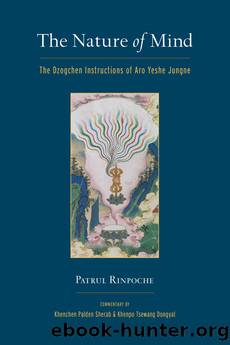The Nature of Mind: The Dzogchen Instructions of Aro Yeshe Jungne by Khenchen Sherab & Khenpo Tsewang Dongyal & Patrul Rinpoche

Author:Khenchen Sherab & Khenpo Tsewang Dongyal & Patrul Rinpoche [Sherab, Khenchen]
Language: eng
Format: epub
Publisher: Shambhala
Published: 2016-04-26T00:00:00+00:00
19: INSTRUCTIONS FOR LESSER CAPABILITY PRACTITIONERS OF MEDIUM CALIBER, INCLUDING SOME POWERFUL SHAMATHA TECHNIQUES
FOR LESSER CAPABILITY practitioners of medium caliber, the following instructions are given in order to gain meditative stability. Maintain the same posture, and intensify the skillful means practices. Then right in front of you, about four cubits away, plant a small stick or twig in the ground so that it stands up vertically. A cubit is approximately the length of the forearm from the elbow to the tip of the middle finger. With strong concentration, unite your mind and your eyes, and look at the upper tip of the stick. This will stabilize your mind. Do not, however, focus too stronglyâthat will make you bored and tired. At the same time, do not be too looseâthat will make you scattered.
In general, when you meditate you should be neither too forceful nor too loose. Avoid extremes and find balance. For this reason, the great wisdom dakini Machik Labdron said that if you are both strong and relaxed in your meditation practice, you will discover the essential point of the view. At first, do this practice on the stick in many short sessions with breaks. As your meditation experience grows you can do longer sessions with shorter breaks.
When your mind becomes more stable, you can change the practice by visualizing a white AH syllable on the upper tip of the stick and concentrate on that. If you prefer, you can visualize a small sphere of light on the upper tip of the stick instead of the AH. This sphere of light can be white, blue, red, yellow, or greenâyou can alternate. But do not change the colors too oftenâkeep a single color for a day. Do this practice gradually, gently, and with balance to avoid the negative side effects we just mentioned.
If you feel you need to do more, replace the stick with small stones or marbles. Above the stones or marbles, you can visualize the white AH syllable or the small sphere of light in one of the five colors. When your mind becomes more stable and you wish to change the object of focus, then instead of visualizing spheres of light outside of yourself, you can visualize them on your forehead, speech, or heart centers. You can visualize the syllables from the Vajrayana teachings: a white OM on your forehead, a red AH on your throat, or a blue HUNG in your heart. Or you can simply stay with the white AH, visualizing it at any one of the three places. According to whatever makes your mind more stable and focused, you may apply any, some, or all of these techniques.
Whenever and however you meditate, be joyful. Do not neglect the skillful means practices. At the beginning of every meditation sessionâand even during the practiceâinvoke good thoughts. Again, do not be too forceful. But also do not back away and lose your courage, commitment, and confidence. If you are on a long retreat, during formal practice sessions,
Download
This site does not store any files on its server. We only index and link to content provided by other sites. Please contact the content providers to delete copyright contents if any and email us, we'll remove relevant links or contents immediately.
Inner Engineering: A Yogi's Guide to Joy by Sadhguru(5897)
The Power of Now: A Guide to Spiritual Enlightenment by Eckhart Tolle(4755)
Fear by Osho(4085)
The Art of Happiness by The Dalai Lama(3384)
The Ultimate Bodybuilding Cookbook by Kendall Lou Schmidt(3320)
Yoga Therapy by Mark Stephens(3222)
Ikigai by Héctor García & Francesc Miralles(3141)
The Little Book of Hygge by Meik Wiking(3081)
Why Buddhism is True by Robert Wright(2826)
The Healing Self by Deepak Chopra(2796)
Being Aware of Being Aware by Rupert Spira(2706)
Shift into Freedom by Loch Kelly(2692)
Wild Words from Wild Women by Stephens Autumn(2589)
Work Clean by Dan Charnas(2562)
Happiness by Matthieu Ricard(2524)
The Hatha Yoga Pradipika (Translated) by Svatmarama(2482)
Yoga Body & Mind Handbook by Jasmine Tarkeshi(2464)
More Language of Letting Go: 366 New Daily Meditations by Melody Beattie(2444)
Why I Am Not a Feminist by Jessa Crispin(2239)
